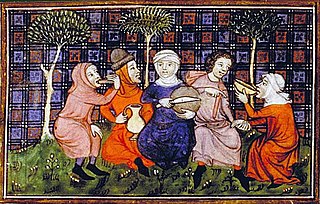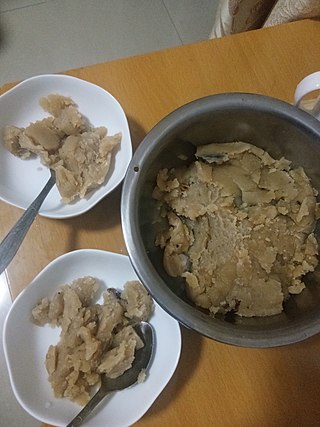
A kitchen is a room or part of a room used for cooking and food preparation in a dwelling or in a commercial establishment. A modern middle-class residential kitchen is typically equipped with a stove, a sink with hot and cold running water, a refrigerator, and worktops and kitchen cabinets arranged according to a modular design. Many households have a microwave oven, a dishwasher, and other electric appliances. The main functions of a kitchen are to store, prepare and cook food. The room or area may also be used for dining, entertaining and laundry. The design and construction of kitchens is a huge market all over the world.

A larder is a cool area for storing food prior to use. Originally, it was where raw meat was larded—covered in fat—to be preserved. By the 18th century, the term had expanded: at that point, a dry larder was where bread, pastry, milk, butter, or cooked meats were stored. Larders were commonplace in houses before the widespread use of the refrigerator.
A royal household or imperial household is the residence and administrative headquarters in ancient and post-classical monarchies, and papal household for popes, and formed the basis for the general government of the country as well as providing for the needs of the sovereign and their relations. It was the core of the royal court, though this included many courtiers who were not directly employed by the monarch as part of the household.

Za'atar is a culinary herb or family of herbs. It is also the name of a spice mixture that includes the herb along with toasted sesame seeds, dried sumac, often salt, as well as other spices. As a family of related Middle Eastern herbs, it contains plants from the genera Origanum (oregano), Calamintha, Thymus, and Satureja (savory) plants. The name za'atar alone most properly applies to Origanum syriacum, considered in biblical scholarship to be the ezov of the Hebrew Bible, often translated as hyssop but distinct from modern Hyssopus officinalis.

Arab cuisine is the cuisine of the Arab world, defined as the various regional cuisines of the Arab people, spanning from the Maghreb to the Fertile Crescent and the Arabian Peninsula. These cuisines are centuries old and reflect the culture of trading in ingredients, spices, herbs, and commodities. The regions have many similarities, but also unique traditions. They have also been influenced by climate, cultivation, and mutual commerce.
The still room is a distillery room found in most great houses, castles or large establishments throughout Europe dating back at least to medieval times.

Medieval cuisine includes foods, eating habits, and cooking methods of various European cultures during the Middle Ages, which lasted from the fifth to the fifteenth century. During this period, diets and cooking changed less than they did in the early modern period that followed, when those changes helped lay the foundations for modern European cuisines.

Chorchori or charchari is a unique char-flavored mixed vegetable dish of India and Bangladesh, found primarily in Odia and Bengali cuisine of the Indian subcontinent.
A saucery was the office in a medieval household responsible for sauces, as well as the room in which the preparation of sauces took place. It was headed by a saucerer. The office was subordinated to the kitchen, and existed as a separate office only in larger households. It was closely connected with other offices of the kitchen, such as the spicery and the scullery. The term is largely obsolete today.
A chandlery was originally the office in a wealthy medieval household responsible for wax and candles, as well as the room in which the candles were kept. It could be headed by a chandler. The office was subordinated to the kitchen, and only existed as a separate office in larger households.
A scalding house was the office in a medieval household responsible for scalding the carcasses of animals, as well as utensils. It was also the room in which this activity took place. It was headed by a scalder. The office was subordinated to the kitchen, and existed as a separate office only in larger households. It was closely connected with other offices of the kitchen, such as the saucery and the scullery.
A poultry was the office in a medieval household responsible for the purchase and preparation of poultry, as well as the room in which the poultry was stored.

Vadouvan, or French curry, is a ready-to-use blend of spices that is a French derivative of a masala known as vadavam, vadagam, or vadakam. It is a curry blend with added aromatics such as shallots and garlic. The spice blend is thought to have originated from French colonial influence in the Puducherry region of India.

Zandabad is a village in Owch Hacha Rural District of the Central District of Ahar County, East Azerbaijan province, Iran.
Powder-douce is a spice mix used in Medieval and Renaissance cookery. Like modern spice mixes such as "Italian seasoning," "garam masala," "taco seasoning," etc., there was not a set ingredient list, it varied from cook to cook. The author of the 14th-century manuscript Le Ménagier de Paris suggested a mix of grains of paradise, ginger, cinnamon, nutmeg, sugar, and galangal.

Dillegrout or dilligrout is a dish traditionally presented at the coronations of kings and queens of England by the holders of the manor of Addington in a kitchen serjeanty. It is generally thought to be a soup or stew made from almond milk, capon, sugar, and spices, but a porridge-like dish of other ingredients has been described. Dillegrout was first presented in 1068 at the coronation of Matilda of Flanders, wife of William the Conqueror, and its final presentation was at the coronation of George IV in 1821.

Tusha Shinni is a halwa dessert from the Sylhet region of Bangladesh. It is soft in texture, sweet and lightly spiced and frequently served on religious holidays.

Records survive of the expenses made to feed the Scottish royal household in the sixteenth century, and the remains of royal kitchens can be seen in the ruins of palaces and castles. Archaeologists can recover evidence of diet from deposits including waste from meals and food preparation.

Spiced vinegar is a type of Philippine vinegar condiment that is made of vinegar e.g. fermented coconut sap infused with spices primarily bird's eye chili and garlic.

One of the earliest documented uses of Yeoman, it refers to a servant or attendant in a late Medieval English royal or noble household. A Yeoman was usually of higher rank in the household hierarchy. This hierarchy reflected the feudal society in which they lived. Everyone who served a royal or noble household knew their duties, and knew their place. This was especially important when the household staff consisted of both nobles and commoners. There were actually two household hierarchies which existed in parallel. One was the organization based upon the function (duty) being performed. The other was based upon whether the person performing the duty was a noble or a commoner.












